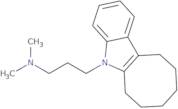Informazioni sul prodotto
- 1-(3-Dimethylaminopropyl)-2,3-hexamethyleneindole
- 3-(6,7,8,9,10,11-hexahydro-5H-cycloocta[b]indol-5-yl)-N,N-dimethylpropan-1-amine
- 5-(3-(Dimethylamino)propyl)-6,7,8,9,10,11-hexahydro-5H-cyclooct(b)indole
- 5H-Cyclooct(b)indole, 5-(3-(dimethylamino)propyl)-6,7,8,9,10,11-hexahydro-
- 5H-Cyclooct(b)indole-5-propanamine, 6,7,8,9,10,11-hexahydro-N,N-dimethyl-
- 6,7,8,9,10,11-Hexahydro-N,N-dimethyl-5H-cyclooct[b]indole-5-propanamine
- Brn 1386299
- Galatur
- Iprindol
- Iprindol [INN-Spanish]
- Vedi altri sinonimi
- Iprindole [USAN:INN:BAN]
- Iprindolum
- Iprindolum [INN-Latin]
- Nsc 169449
- Pramindole
- Prondol
- Tertran
- Unii-69U0Ikr8Fp
- Wy-3263
- Wy-3263 (VAN)
- Iprindole
Iprindole is a low-potency antidepressant drug with a tricyclic structure. It is used as an experimental model for the study of the physiological and pharmacological effects of antidepressants. Iprindole has been shown to increase locomotor activity in rats, which may be due to its 5-HT agonist activity. Iprindole is also known to have receptor activity at 5-HT2 receptors, which may account for its antidepressant effect. Iprindole has been shown to have a high affinity for dopamine receptors, which may account for its stimulant properties. The drug has been shown to produce toxicity in mice and rats, but not in dogs or monkeys; it is therefore considered safe for use in humans.





